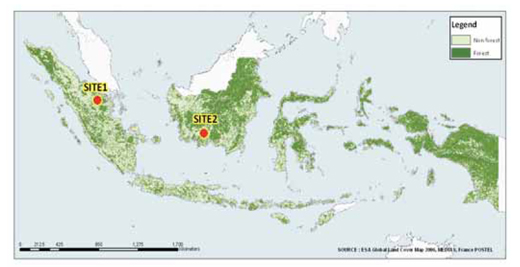The carbon debt of palm oil
08/08/09
World Agroforestry Centre (ICRAF) scientists have published data on the storage of carbon in palm oil plantations.
Palm oil plantations continue to be one of the most controversial topics of modern environmentalism. Forests throughout the tropical belt are cleared resulting in significant biodiversity loss and the displacement of indigenous people. But now there is a fresh threat: carbon debt. Deforestation is responsible for approximately 20 per cent of all greenhouse gas emissions meaning that countries such as Brazil and Indonesia are some of the biggest carbon emitters on the planet.
I have listened to supporters of palm oil plantations - granted they were typically representatives of the Malaysian and Indonesian palm oil boards - say that the plantations are not a cause of climate change as, for want of a better expression, "a tree is a tree".
This has maddened conservationists for years because the irony of chopping down one of the planet's great carbon stores - tropical rainforests - in order to grow biofuels (palm oil is also used in many processed foods, confectionery and cosmetics) to help combat climate change is farcical.
But new research from ICRAF looks set to change that point of view and bolster the the argument against the conversion of forest.
ICRAF define the greenhouse gas emissions due to the production of palm oil in three phases of the production process:
- the initial conversion of preceding vegetation into a palm oil plantation, usually cased on "land clearing", leading to a "C debt"
- the balance of emission and absorption during the growth cycle of the oil palms, depending on the growth rate, green manure and organic waste management and fertiliser practices, leading to a time-averaged C-stock that influences "C debt" and repay time
- transport to the refinery followed by CPO and kernel production, transesterification into biofuel and further transport to the end users.
The pilot study was carried out at two sites in Sumatra and Kalimantan and they found that mature palm oil plantations store less than 40 tons of above-ground biomass. Logged-over forests on the project sites stored between 70 and 200 tons of carbon. Virgin forest contains significantly more carbon still.

The Project locations in Sumatra (site 1) and Kalimantan (site 2)
Image courtesy of ICRAF
All this is important because it helps to define the carbon payback of a plantation. Typically a plantation is re-planted in 25 year cycles and, therefore, if the carbon payback time exceeds 25 years then palm oil biodiesel would generate greater emissions than petroleum.
The study naturally concludes by recommending that oil palm plantations should not be grown on land with an above ground carbon stock of more than 40 tons per hectare, which could include grassland and abandoned agricultural sites. Of course plantation owners don't like this option as it means they lose the easy pickings the forest timber offers. Selling the timber from a forest means they can earn an income while the palms mature and fruit; a process that can take about six years.
As the REDD concept gathers momentum carbon payments to plantation owners to avoid deforestation may begin to compete with this initial timber income and tempt them into a different tactic. Some of the largest palm oil companies have already shown some interest in this strategy.